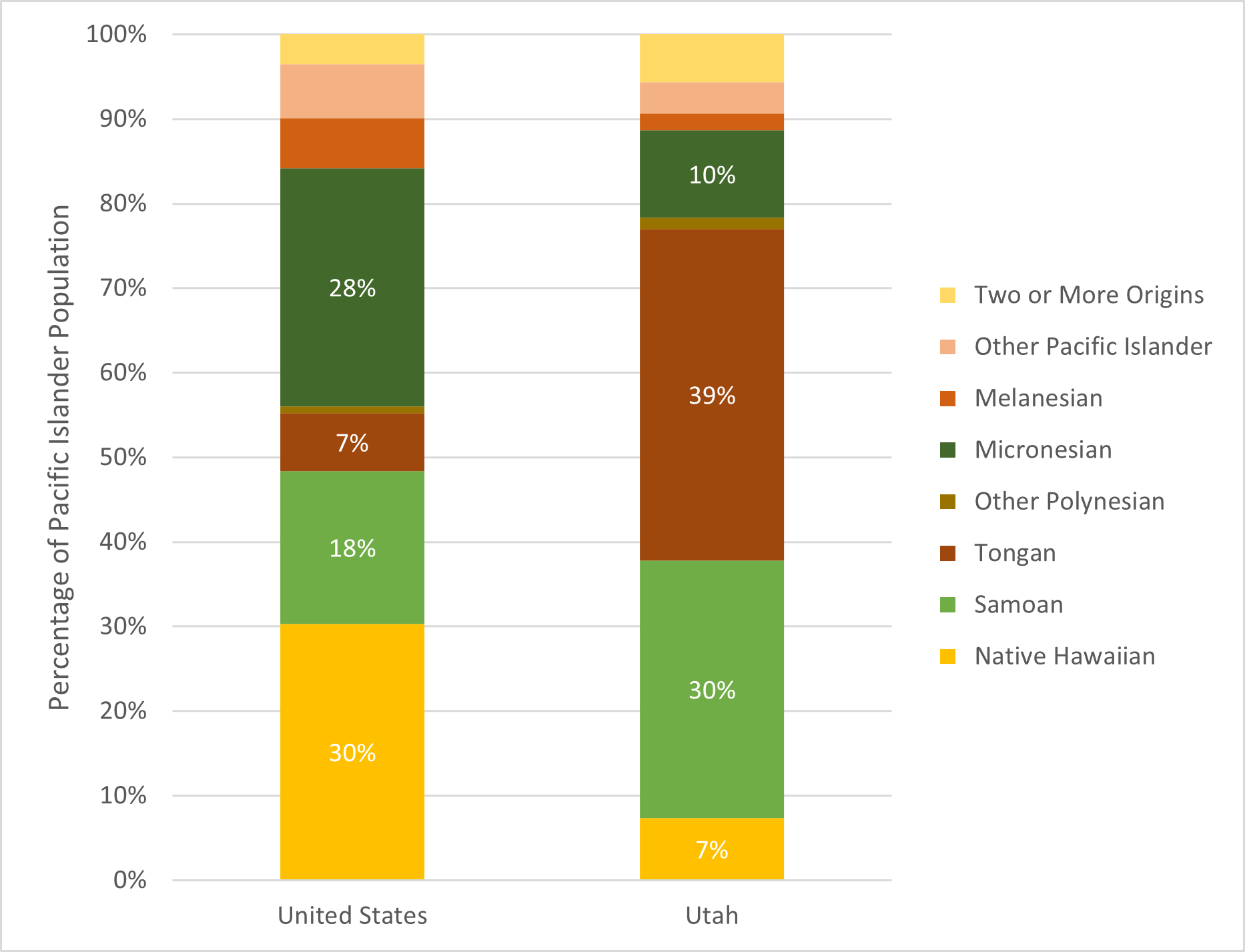Blog Post
Insight: Utah’s Pacific Islander Community
By Heidi Prior
Note: The opinions expressed are those of the author alone and do not reflect an institutional position of the Gardner Institute. We hope the opinions shared contribute to the marketplace of ideas and help people as they formulate their own INFORMED DECISIONS™.
Sep 23, 2022 – August was Pacific Island Heritage Month in Utah. Though the festivities have mostly wrapped up, it’s never too late to reflect on data around this unique segment of Utah’s population. Utah has a long history of Native Hawaiian or Other Pacific Islander residents, but this blog summarizes findings from the most recent data – the 2016-2020 American Community Survey 5-year estimates and the 2020 census redistricting data.
In these estimates, over 1,440,000 U.S. residents, or 0.4% of the U.S. population, identified as “Native Hawaiian or Other Pacific Islander” either alone or in combination with other racial categories. Here in Utah, this group, which we will refer to as Pacific Islanders, composed a much larger portion of the state population: 1.6%.
With close to 50,000 Pacific Islanders, Utah boasts the fifth largest state-wide Pacific Islander population in the nation, after Hawaii, California, Washington, and Texas. Utah ranks third for the share of Pacific Islanders in the state’s population. Only Hawaii and Alaska have higher proportions of Pacific Islanders.
Figure 1. Number of Native Hawaiian or Other Pacific Islanders Alone or in Combination by State, 2016-2020

Within Utah, Pacific Islanders are concentrated in Utah’s most populous counties. They compose the largest shares of the total population in Salt Lake County (2.4%), Utah County (2.0%), and Washington County (1.6%). Davis, Sanpete, and Tooele Counties also include sizeable Pacific Islander populations.
Additional Insights into the Native Hawaiian and Pacific Islander Alone Population
The majority, or 60%, of Utah’s Pacific Islanders selected Native Hawaiian or Other Pacific Islander as their sole racial identifier. Data from the Census Bureau describes these residents in greater detail than those who include Native Hawaiian or Pacific Islander as a part of their multiracial identity. The following insights are drawn from analyses of this Pacific Islander “alone” population. Learn more about the Census Bureau’s concepts of race and ethnicity here.
Utah’s Pacific Islander population is growing faster than the state. Between 2010 and 2020, the Pacific Islander population increased by 50% (almost 12,000 residents) compared to a statewide increase of 18% in the total population.
The ethnic origins of Utah’s Pacific Islanders differ from Pacific Islanders nationwide. In the most recent data, Utah’s Pacific Islanders described themselves as 39% Tongan, 30% Samoan, 10% Micronesian, 7% Native Hawaiian, and 2% Fijian. 4% identified as Other Pacific Islanders and 6% selected two or more origins. While Samoan and Tongan Utahns composed 69% of Utah’s Pacific Islanders, only a quarter of Pacific Islanders nationally fell into these two groups. Pacific Islanders nationwide were much more likely than their Utah peers to identify as Native Hawaiian or Micronesian. These estimates do not include residents of U.S. island areas such as Guam or American Samoa.
Figure 2. United States and Utah Pacific Islander Population Proportions by Origin, 2016-2020
Note: The U.S. Pacific Islander population includes Pacific Islanders living in the 50 states, the District of Columbia, and Puerto Rico.
Source: U.S. Census Bureau, 2016-2020 American Community Survey 5-Year Estimates
Utah is a hub for Tongan Americans. Tongans compose 39% of Utah’s Pacific Islander community, making them the state’s largest Pacific Islander group. This demographic is unique. Tongans compose only 7% of Pacific Islanders nationwide, and sizeable communities exist in only a handful of U.S. states. In fact, 80% of Tongan residents live in just three states: California, Utah, and Hawaii. More than a quarter of the nation’s Tongan population resides in Utah.
Samoans are Utah’s 2nd largest Pacific Islander group. 30% of Utah’s Pacific Islanders identify as Samoan, a group that accounts for 18% of Pacific Islanders in the continental U.S., Alaska, and Hawaii. Double the size of the U.S. Tongan population, Samoan residents are more widely distributed throughout the 50 states. Though most live in western states or Texas, large communities are also found in the Midwest, Southeast, and Northeast. Utah has the 4th largest Samoan population in the U.S.
Heidi Prior is a research associate at the Kem C. Gardner Policy Institute.







